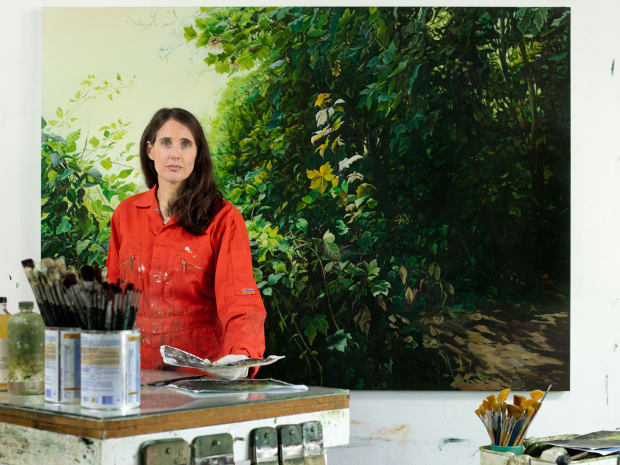-
HOLLOW POND: HANNAH BROWN
by Dr.Susan Owens -

Hollow Pond 4, 2023, Oil on linen, 100 x 90 cm, 39 3/8 x 35 3/8 in
-

Hollow Pond 1 (detail), 2022-23, Oil on linen, 150 x 200 cm, 59 x 78 3/4 in
-
 Day for Dusk (Hollow Pond) 2, 2023, Oil and acrylic on canvas, 100 x 90 cm, 39 3/8 x 35 3/8 in
Day for Dusk (Hollow Pond) 2, 2023, Oil and acrylic on canvas, 100 x 90 cm, 39 3/8 x 35 3/8 in -
'Her Hollow Pond paintings brim with elusive meanings and suggest both beginnings and endings, joy and melancholy' -
 Hollow Pond 6, 2023, Oil on linen, 130 x 180 cm, 51 1/8 x 70 7/8 in
Hollow Pond 6, 2023, Oil on linen, 130 x 180 cm, 51 1/8 x 70 7/8 in -
Brown is a master of detail. She paints each leaf, whether flourishing or turning brown, with loving attention. Like Constable, she is a painter of the overlooked and the marginal; she honours the trees and hedges, leaves and branches of nowhere in particular with her close attention. But her paintings are about much more than detail. Each reverberates with a sense of enchantment, though whether benign or disturbing is hard to say. What is visible of sky glows with the kind of evocative, evanescent light that comes only at dawn or dusk. Her Hollow Pond paintings brim with elusive meanings and suggest both beginnings and endings, joy and melancholy. Empty of people, they are stage-sets before the play begins – or after it has ended.At first they reminded me of a picture in the Victoria and Albert Museum I adored as a teenager: Disappointed Love by the Irish artist Francis Danby, painted in 1821. It shows a heartbroken young woman sitting on the bank of a lake with her head in her hands, her white dress shining out against sinister dark foliage. Details elaborate her story: a portrait miniature of a young man lies on the grass next to her, and she has torn up a letter and thrown it into the dark water. These days, though, I can see its limitations: Danby has grasped us by the elbow and, indicating this or that detail, regaled us with the whole sad tale. Brown, by contrast, refuses to be drawn. Her kind of detail does not give the game away. The subtle ambiguities of her paintings awaken our curiosity and ignite our imaginations: they pull us in and compel us to keep on looking.So how do we experience the natural world today, no longer in lockdown but against daily reports of ever-higher temperatures, floods and wild fires? In an oblique and lyrical way, Brown addresses the question by valuing the local landscape, however scrubby and marginal. By connecting with nature, finding in it a source not only of anxiety but also of joy. By falling in love with hedgerows and leafy banks and communicating it through paint. Painting, after all, is but another word for feeling.
Susan Owens
August 2023
-

all photographs by Peter Mallet




